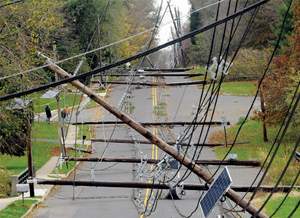
The national election and the aftermath of Superstorm Sandy provide a double measure of poignancy to this week's issue—the fifth in ENR's critical-infrastructure series of special reports. This installment, planned months ago, focuses on the electrical grid. Although infrastructure had not been part of the political conversation prior to this storm of storms, we hope the disaster in the Northeast U.S. refocuses public concern.
With its twin assault of wind and storm surge, a tempest of this size and character is bound to cause widespread outages. Even the most modern smart grid can't function when large sections of distribution are destroyed. Substations, lines and switches soaked in saltwater cannot function.
That said, Sandy's damage and ENR's special report suggest that investor-owned utilities and public-service commissions that control rate increases should be compelled to place more emphasis on smart sensors to help the grid recover from outages. Until now, the U.S. Energy Dept. has spent too much money on meters that do little to make grids, or the consumers that use them, smarter.
The Chattanooga Example
There are causes for optimism. For example, smart-grid investment helped Chattanooga, Tenn.'s publicly owned utility EPB bounce back quickly from a major outage last July. Con Ed and other utilities in Sandy's damage zone had been deploying 39 phasor measurement units—supersensors that convey data about the grid to control systems—through the New York state grid even as the storm hit.
Even the smartest grid will go down, however, if its distribution side depends on poles that are underdesigned and underbuilt. Otto Lynch, a structural engineer and vice president of Power Line Systems Inc., points out that distribution-line poles under 60 ft tall are exempt from code requirements for transmission lines (see story, p. 20). As a result, Sandy took out these weak links. "I haven't heard of a single instance of transmission-side failure," Lynch says. "Until the PUCs [public utility commissions] step up and force code changes, we'll keep getting the same result."
The governors of New York, New Jersey and Connecticut all have warned local utilities that there would be consequences if power-line crews are late in restoring service to customers. The governors—and all future candidates for public office—should push their public-service commissions to encourage smart-grid investment by utilities. Even before that, they should push the PUCs to remove the 60-ft exemption for any replacement poles, a move that would strengthen the weakest link in the electrical grid.

Post a comment to this article
Report Abusive Comment